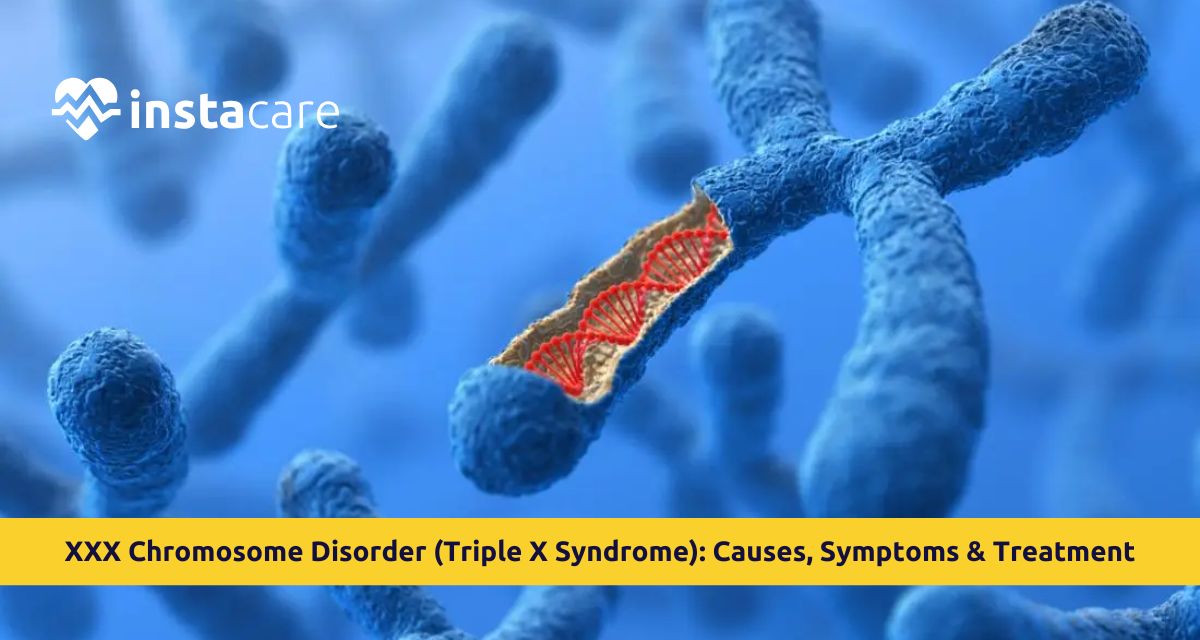What is XXX Chromosome Disorder?
Triple X syndrome or XXX chromosome defect is a birth abnormality found in women who are born with an extra chromosome. Instead of the usual two X chromosomes (46,XX), these subjects possess three (47,XXX). It is a chromosomal defect that occurs in approximately 1 in every 1,000 females but is largely unaware due to symptoms that are subtle or none at all.
Causes of XXX Chromosome Disorder
Causes of XXX chromosome disorder are due to an occurrence called nondisjunction during cell development of the reproductive cell.
- Nondisjunction takes place when chromosomes fail to separate as they should and an egg cell has an extra X chromosome.
- When this type of egg cell is fertilized with a normal sperm carrying an X chromosome, the result is a triple digit of X chromosomes (47,XXX).
- The condition also arises after conception when in the process of cell division, there is Chromosomal abnormalities of the cells causing mosaicism where half the cells carry the extra chromosome and the other half do not (46,XX/47,XXX). This is more likely to lead to mild symptoms.
Symptoms of XXX Chromosome Disorder
Symptoms of XXX chromosome disorder are very unpredictable. The majority of girls and women with the disorder are asymptomatic, whereas others will have mild to moderate developmental and physical issues. Some of the common symptoms are:
- Height that is above average
- Delayed speech and language
- Mild learning disability for writing and reading
- Motor skill delay, such as sitting, crawling, or walking
- Muscle weakness in infants (hypotonia)
- Difficulty with coordination
- Bad Moods or behavior problem
- Increased anxiety and mood disorder risk
Despite all these symptoms, XXX chromosome life expectancy is normal and that the majority of women can lead normal active lives.
XXX Chromosome Disorder in Children
- The most overt signs in XXX chromosome disorder in children will manifest early in childhood.
- Delayed speech, delay in motor skills acquisition, and mental disabilities in school functioning are common.
- Physical characteristics such as height increase and nominally reduced head circumference may be present, or not.
- Early intervention from speech, occupational, and special education therapists can make huge impact to the child's existence and ego.
XXX Chromosome Disorder in Adults
- Triple X syndrome in grown-ups will not cause nystagmus or other pathology of eye movement but can do so.
- Women with Triple X syndrome can be normal, develop normally sexually, and remain fertile.
- They can exhibit issues with fertility, abnormal periods, or early menopause in some.
- They can also be affected psychologically and incur a greater incidence of depression or social anxiety, usually concerning previous XXX chromosome developmental delays.
Diagnosis of XXX Chromosome Disorder
XXX chromosome diagnosis will more frequently be an incidental diagnosis during having genetic testing for some other purpose, e.g., when undergoing fertility testing or pregnancy testing prior to birth.
- Prenatal testing, Amniocentesis or chorionic villus sampling (CVS) will find the extra chromosome prenatally.
- Postnatal diagnosis: A karyotype test, which examines the number and position of the chromosomes, is used in an attempt to make the diagnosis.
Due to the fact that the vast majority of XXX chromosome disorder in females are so mild, the condition may be missed during life.
Types and Variations of XXX Chromosome Disorder
While Triple X syndrome karyotype is usually 47,XXX in all cells, mosaicism, including 46,XX/47,XXX, can happen to others, who have lesser signs and symptoms. Another variant, although uncommon, is more than three X chromosomes with increased development and health issues.
Complications Associated with XXX Chromosome Disorder
XXX chromosome disorder complications are not fatal but may affect quality of life. Complications include:
- Learning and school difficulties
- Speech and language retardation
- Behavior or emotional difficulties
- Bent little fingers (clinodactyly) small bones deformities
- Higher risk of autoimmune condition or unusual kidney (rarely)
Normal XXX chromosome fertility but the women have reduced fertility levels or premature menopause.
Treatment and Management of XXX Chromosome Disorder
Triple X syndrome is not curable, but symptom control and maximum development potential are typically the issue in treatment. Triple X syndrome treatment is typically:
- Speech therapy: To maintain language development and increase communication capability.
- Occupational therapy: Motor capability and coordination capability.
- Learning assistance: Special in-school methods for learning.
- Counseling and therapy: For behavior and emotional problems. Therapynice.
Paranoia therapy or anxiety management would consist of cognitive behavior therapy for paranoia and stress management techniques. Paranoia medication or
antidepressants would, in very rare situations, be prescribed.
How to Cope with XXX Chromosome Disorder?
Treatment of Triple X syndrome is a combination of healthcare, therapy, and counseling. The parents have to:
- Speak about learning disability openly
- Provide stable education and emotional support
- Create self-esteem through good accomplishments and hobbies
- Seek professional help in instances of development or behavioral issues
Most women and girls with Triple X syndrome can be outstanding academically, socially, and professionally if they are provided with a proper support group.
Conclusion
XXX chromosome disorder, also known as Triple X syndrome, is mild Genetic disorders in females with absolutely no symptom at all that is usually not identifiable. With the right care support, identification, and periodic follow-up examinations, the majority of women affected with this situation can live normal and healthy lives. Early solution treatment is the utmost in solving developmental complications and general health.
Please book an appointment with the
best Gynecologist in Lahore, Karachi, Islamabad, and all major cities of Pakistan through
InstaCare, or call our helpline at 03171777509 to find the verified doctor for your disease.

